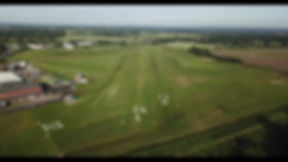
LOCAL AIRSPACE & PROCEDURES
For the first time visitor, flying in to Manchester Barton Aerodrome can appear to be daunting. However, most would agree that its really quite simple. The information provided here is intended to give further guidance to help you plan your flight.
North West Transit Corridor
From 20th February 2025, the Manchester LLR will become the 'North West Transit Corridor'. The airspace will revert from Class D to Class G and become Restricted Area EGR323. The UK CAA information circular Y 004/2025 as follows is accessible here. A summary for your convenience is detailed below:
Summary of North West Transit Corridor
Manchester Low Level Route (MLLR) Removal
-
The MLLR will cease to exist at 0001 hours on 20 February 2025.
-
It will be replaced by the North West Transit Corridor (NWTC).
Introduction of Restricted Area EGR323 (NWTC)
-
The NWTC will provide Class G airspace up to 1500 FT AMSL.
-
Above 1500 FT AMSL, the airspace remains Class D and is renamed Manchester Control Area 6 (CTA-6) (extending up to 3500 FT AMSL).
Flight Restrictions & Exemptions:
Aircraft are prohibited from transiting through EGR323 unless specific conditions are met:
-
Max 140 KTS IAS
-
Min 5 KM in-flight visibility
-
Max Take-Off Mass 40,000 KG
-
Use of Manchester or Liverpool QNH (The Manchester QNH can also be obtained from Barton Information)
Exemptions for emergency services, including:
-
Police Air Support
-
Emergency Medical Services
-
The King's Helicopter Flight
-
Maritime & Coastguard Agency (SAR only)
Air Traffic Control & Monitoring
-
ATC clearance is not required within EGR323 if the above conditions are met.
-
Aircraft unable to meet conditions can apply for an exemption (referencing UK AIP ENR 5.1).
-
Frequency monitoring is recommended but not mandatory:
-
Manchester FMC 7366 (Channel 118.580)
-
Liverpool FMC 5060 (Channel 119.855)
-
Updated VFR Charts
-
New airspace classifications will be reflected on 1:500,000 and 1:250,000 VFR charts.
Arriving from the South (North West Transit Corridor)
From 20th February 2025, the Manchester LLR will become the 'North West Transit Corridor'.
We would recommend monitoring or receiving a radar service from locally equipped units (Liverpool or Manchester) prior to arriving at Barton as per circular Y 004/2025. Pilots are welcome to request a basic service from Barton Information on 120.255MHz when in class G airspace and within 10nm of Manchester Barton Aerodrome.
Arriving from the North
The airspace is class G up to 2000 ft QNH and there is no requirement to talk to Manchester when transiting to/from the airfield.
Inbound RTF call
From any direction we would recommend that your inbound call is made to Barton Information is made in good time before reaching the ATZ to ensure a timely communication is established with the AFISO. If you are asked to standby, we ask that you remain outside the ATZ and await the AFISO to call you back.
Non Radio Aircraft
Non Radio Aircraft are not routinely permitted. In the event of a radio failure, aircraft should squawk 7600 and observe the signal square and look for light signals provided from the tower.
Joining the Circuit - Fixed Wing
The Standard Circuit Join is to approach the field overhead at 1700 feet on the Barton QFE then to commence a descent on the deadside to the fixed wing circuit height of 1000 feet Barton QFE. Keep a good lookout for other aircraft that may be joining the same circuit pattern. The FISO will issue relevant traffic information to assist with with integration into any other circuit traffic that might be present.
Fixed Winged pilots are advised that the helicopter training circuits are carried out at 500 feet underneath the fixed wing circuit. The helicopter circuit climbout and final approach however, remain clear of the runway in use.
Joining the Circuit - Helicopters
There are 3 main arrival routes published for helicopters. These are designed to ensure that helicopter traffic is separated from fixed winged procedures. These are available from the AIS website.
Unless otherwise requested, helicopters should route via a designated point. The FISO will issue relevant traffic information to assist with a safe approach.
Helicopter circuits are flown at 500ft Barton QFE underneath the fixed wing circuit (1000ft). Approaches are made to either Heli East or Helicopter Training Area North (HTA N) with due regard to the runway in use.
Manchester Barton is located in close proximity to controlled airspace, to enable adjacent radar equipped air traffic units to identify that aircraft are in communication with ‘Barton Information’ a conspicuity squawk is in use.
Aircraft may be allocated a squawk of ‘7365’ on initial contact with Barton Information.
Pilots must not squawk 7365 until advised to do so. Those aircraft that are not transponder equipped should advise ‘Negative Transponder’
The allocation of squawk ‘7365’ includes the selection, where fitted, of Mode ‘C’ on the aircraft’s transponder.
(It is stressed that Barton Information have no access themselves to radar and no form of radar service is implied by the use of this squawk)
Manchester Barton successfully trialled the use of electronic conspicuity with the Civil Aviation Authority and Airspace4All using an ADS-B Traffic Display within our Air Traffic unit. It is worth noting to pilots that whilst this system is in use, no form of elevated service is implied and the equipment used solely for situational awareness of the ATSU.
